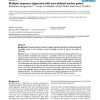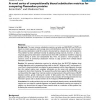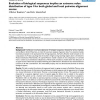158 search results - page 20 / 32 » Complementarity of network and sequence information in homol... |
ALMOB
2006
13 years 8 months ago
2006
Background: Automated software tools for multiple alignment often fail to produce biologically meaningful results. In such situations, expert knowledge can help to improve the qua...
BMCBI
2008
13 years 8 months ago
2008
Background: The most common substitution matrices currently used (BLOSUM and PAM) are based on protein sequences with average amino acid distributions, thus they do not represent ...
BMCBI
2008
13 years 8 months ago
2008
Background: Confidence in pairwise alignments of biological sequences, obtained by various methods such as Blast or Smith-Waterman, is critical for automatic analyses of genomic d...
ISMB
2000
13 years 10 months ago
2000
Knowing the number of residue contacts in a protein is crucial for deriving constraints useful in modeling protein folding, protein structure, and/or scoring remote homology searc...
BMCBI
2005
13 years 8 months ago
2005
Background: We present a biological data warehouse called Atlas that locally stores and integrates biological sequences, molecular interactions, homology information, functional a...



